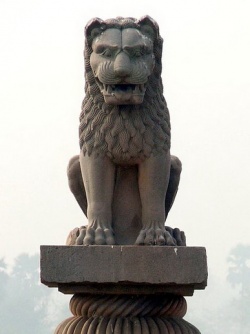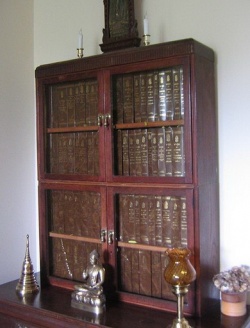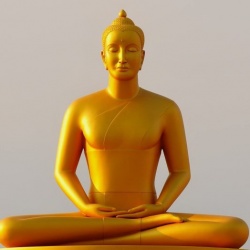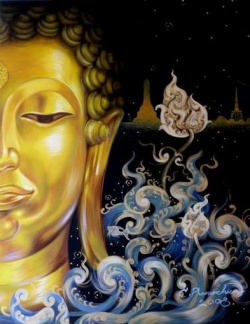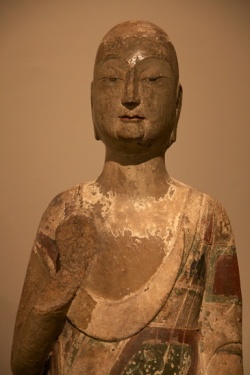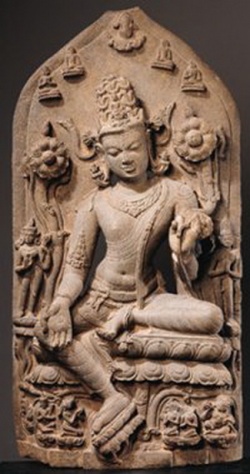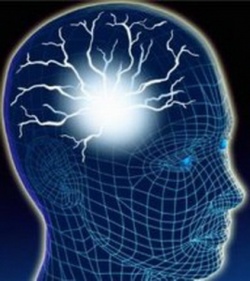Pāli Canon
The Pāli Canon (Pali: Tipitaka) is the standard collection of scriptures in the Theravada Buddhist tradition, as preserved in the Pāli language.[1] It is the most complete extant early Buddhist canon.It was composed in North India, and preserved orally until it was committed to writing during the Fourth Buddhist Council in Sri Lanka in 29 BCE, approximately four hundred and fifty four years after the death of Shākyamuni.
The Pāli Canon falls into three general categories, called pitaka (from Pali piṭaka, meaning "basket", referring to the receptacles in which the scrolls were kept). Because of this, the canon is traditionally known as the Tipiṭaka (Sanskrit: Tripiṭaka; "three baskets"). The three pitakas are as follows:
Vinaya Pitaka ("Discipline Basket"), dealing with rules for monks and nuns
Sutta Pitaka (Sutra/Sayings Basket), discourses, mostly ascribed to the Buddha, but some to disciples
Abhidhamma Pitaka, variously described as philosophy, psychology, metaphysics, etc.
The Vinaya Pitaka and the Sutta Pitaka are remarkably similar to the works of other early Buddhist schools. The Abhidhamma Pitaka however is a strictly Theravada collection, and has little in common with the Abhidhamma works recognized by other Buddhist schools.
ly described by the Theravada as the Word of the Buddha (buddhavacana), though this is obviously not intended in a literal sense, since it includes teachings by disciples.
The traditional Theravādin (Mahavihārin) interpretation of the Pali Canon is given in a series of commentaries covering nearly the whole Canon, compiled by Buddhaghosa (fl. 4th–5th century CE) and later monks, mainly on the basis of earlier materials now lost. Subcommentaries have been written afterward, commenting further on the Canon and its commentaries. The traditional Theravādin interpretation is summarized in Buddhaghosa's Visuddhimagga.
An official view is given by a spokesman for the Buddha Sasana Council of Burma:the Canon contains everything needed to show the path to nirvāna; the commentaries and subcommentaries sometimes include much speculative matter, but are faithful to its teachings and often give very illuminating illustrations. In Sri Lanka and Thailand, "official" Buddhism has in large part adopted the interpretations of Western scholars.
Although the Canon has existed in written form for two millennia, its earlier oral nature has not been forgotten in actual Buddhist practice within the tradition: memorization and recitation remain common. Among frequently recited texts are the Paritta. Even lay people usually know at least a few short texts by heart and recite them regularly; this is considered a form of meditation, at least if one understands the meaning. Monks are of course expected to know quite a bit more (see Dhammapada below for an example). A Burmese monk named Vicittasara even learned the entire Canon by heart for the Sixth Council (again according to the usual Theravada numbering). Recitation is in Pali as the ritual language.
The relation of the scriptures to Buddhism as it actually exists among ordinary monks and lay people is, as with other major religious traditions, problematical: the evidence suggests that only parts of the Canon ever enjoyed wide currency, and that non-canonical works were sometimes very much more widely used; the details varied from place to place.[14] Rupert Gethin suggests that the whole of Buddhist history may be regarded as a working out of the implications of the early scriptures.
Origins
According to a late part of the Pali Canon, the Buddha taught the three pitakas.[16] It is traditionally believed by Theravadins that most of the Pali Canon originated from the Buddha and his immediate disciples. According to the scriptures, a council was held shortly after the Buddha's passing to collect and preserve his teachings. It was recited orally from the 5th century BCE to the first century BCE, when it was written down. The tradition holds that only a few later additions were made. The pitakas were first written down in Sri Lanka in the Alu Viharaya Temple.
Much of the material in the Canon is not specifically Theravādin, but is instead the collection of teachings that this school preserved from the early, non-sectarian body of teachings. According to Peter Harvey, it contains material which is at odds with later Theravādin orthodoxy. He states that "the Theravādins, then, may have added texts to the Canon for some time, but they do not appear to have tampered with what they already had from an earlier period." A variety of factors suggest that the early Sri Lankan Buddhists regarded canonical literature as such and transmitted it conservatively.[18]
Attribution according to scholars
The views of scholars concerning the attribution of the Pali Canon can be grouped into three categories:
Attribution to the Buddha himself.
Attribution to the period of pre-sectarian Buddhism.
Agnosticism.
Scholars have both supported and opposed the various existing views.
Views concerning attribution to the Buddha himself
Several scholars who specialize in the field of early Buddhism have said that much of the contents of the Pali Canon (and its main teachings) can be attributed to Gautama Buddha. Richard Gombrich says that the main preachings of the Buddha (as in the Vinaya and Sutta Pitaka) are coherent and cogent, and must be the work of a single genius: the Buddha himself, not a committee of followers after his death. Peter Harvey also affirms the authenticity of "much" of the Pali Canon. A.K. Warder has stated that there is no evidence to suggest that the shared teaching of the early schools was formulated by anyone else than the Buddha and his immediate followers. J.W. de Jong has said it would be "hypocritical" to assert that we can say nothing about the teachings of earliest Buddhism, arguing that "the basic ideas of Buddhism found in the canonical writings could very well have been proclaimed by him [the Buddha), transmitted and developed by his disciples and, finally, codified in fixed formulas." A. Wynne has said that the Pali Canon includes texts which go back to the very beginning of Buddhism, which perhaps include the substance of the Buddha’s teaching, and in some cases, maybe even his words. Hajime Nakamura writes that while nothing can be definitively attributed to Gautama as a historical figure, some sayings or phrases must derive from him.
Views concerning attribution to the period of pre-sectarian Buddhism
History of literature
by era
Bronze Age
Sumerian
Ancient Egyptian
Akkadian
Classical
Chinese
Greek
Hebrew
Latin
Pahlavi
Pali
Prakrit
Sanskrit
Syriac
Tamil
Early Medieval
Matter of Rome
Matter of France
Matter of Britain
Byzantine
Kannada
Persian
Turkish
Medieval
Old Bulgarian
Old English
Middle English
Arabic
Byzantine
Catalan
Dutch
French
German
Indian
Old Irish
Italian
Japanese
Kannada
Nepal Bhasa
Norse
Persian
Telugu
Turkish
Most scholars do agree that there was a rough body of sacred literature that a relatively early community maintained and transmitted.[26] Much of the Pali Canon is found also in the scriptures of other early schools of Buddhism, parts of whose versions are preserved, mainly in Chinese. Many scholars have argued that this shared material can be attributed to the period of Pre-sectarian Buddhism. This is the period before the early schools separated in about the fourth or third century BCE.
Views concerning agnosticism
Some scholars see the Pali Canon as expanding and changing from an unknown nucleus. Arguments given for an agnostic attitude include that the evidence for the Buddha's teachings dates from (long) after his death.
Some scholars of later Indian Buddhism and Tibetan Buddhism say that little or nothing goes back to the Buddha. Ronald Davidson has little confidence that much, if any, of surviving Buddhist scripture is actually the word of the historical Buddha. Geoffrey Samuel says the Pali Canon largely derives from the work of Buddhaghosa and his colleagues in the 5th century AD. Gregory Schopen argues that it is not until the 5th to 6th centuries CE that we can know anything definite about the contents of the Canon. This position was criticized by A. Wynne.
The earliest books of the Pali Canon
Different positions have been taken on what are the earliest books of the Canon. The majority of Western scholars consider the earliest identifiable stratum to be mainly prose works, the Vinaya (excluding the Parivāra) and the first four nikāyas of the Sutta Pitaka, and perhaps also some short verse works such as the Suttanipata. However, some scholars, particularly in Japan, maintain that the Suttanipāta is the earliest of all Buddhist scriptures, followed by the Itivuttaka and Udāna. However, some of the developments in teachings may only reflect changes in teaching that the Buddha himself adopted, during the 45 years that the Buddha was teaching.
Most of the above scholars would probably agree that their early books include some later additions. On the other hand, some scholars have claimed that central aspects of late works are or may be much earlier.
According to the Sri Lankan Mahavamsa, the Pali Canon was written down in the reign of King Vattagāmini (Vaṭṭagāmiṇi) (1st century BCE) in Sri Lanka, at the Fourth Buddhist council. Most scholars hold that little if anything was added to the Canon after this, though Schopen questions this.
Texts and translations
The climate of Theravāda countries is not conducive to the survival of manuscripts. Apart from brief quotations in inscriptions and a two-page fragment from the eighth or ninth century found in Nepal, the oldest manuscripts known are from late in the fifteenth century, and there is not very much from before the eighteenth.
The first complete printed edition of the Canon was published in Burma in 1900, in 38 volumes. The following editions of the Pali text of the Canon are readily available in the West:
Pali Text Society edition, 1877–1927 (a few volumes subsequently replaced by new editions), 57 volumes including indexes, individual volumes also for sale separately.
The Pali scriptures and some Pali commentaries were digitized as an MS-DOS/extended ASCII compatible database through cooperation between the Dhammakaya Foundation and the Pali Text Society in 1996 as PALITEXT version 1.0: CD-ROM Database of the Entire Buddhist Pali Canon ISBN 978-974-8235-87-5. The Dhammakāya Foundation are currently negotiating with the Pali Text Society to make available an updated database which adds the English translations and Windows/Unicode compatibility.
Thai edition, 1925–28, 45 volumes; more accurate than the PTS edition, but with fewer variant readings;
BUDSIR on Internet free with login; and electronic transcript by BUDSIR: Buddhist scriptures information retrieval, CD-ROM and online, both requiring payment.
Sixth Council edition, Rangoon, 1954–56, 40 volumes; more accurate than the Thai edition, but with fewer variant readings;
electronic transcript by Vipāssana Research Institute available online[49] in searchable database free of charge, or on CD-ROM (p&p only) from the institute.
Another transcript of this edition, produced under the patronage of the Supreme Patriarch of Thailand, World Tipitaka Edition, 2005, 40 volumes, published by the Dhamma Society Fund, claims to include the full extent of changes made at the Sixth Council, and therefore reflect the results of the council more accurately than some existing Sixth Council editions. Available for viewing online (registration required) at Tipiṭaka Quotation WebService.
Sinhalese (Buddha Jayanti) edition, 1957–?1993, 58 volumes including parallel Sinhalese translations, searchable, free of charge (not yet fully proofread.) Available at Journal of Buddhist Ethics.
Sinhalese (Buddha Jayanti). Image files in Sinhala script. The only accurate version of the Sri Lankan text available, in individual page images. Cannot be searched though.
Transcript in Budhgaya News Pali Canon. In this version it is easy to search for individual words across all 16,000+ pages at once and view the contexts in which they appear.
No one edition has all the best readings, and scholars must compare different editions.
The Complete Collection of Chinese Pattra Scripture
Translation: Pali Canon in English Translation, 1895-, in progress, 43 volumes so far, Pali Text Society, Bristol; for details of these and other translations of individual books see the separate articles. In 1994, the then President of the Pali Text Society stated that most of these translations were unsatisfactory.[58] Another former President said in 2003 that most of the translations were done very badly. The style of many translations from the Canon has been criticized as "Buddhist Hybrid English", a term invented by Paul Griffiths for translations from Sanskrit. He describes it as "deplorable", "comprehensible only to the initiate, written by and for Buddhologists".
Selections: see List of Pali Canon anthologies.
Contents of the Canon
Pali Canon
Vinaya Pitaka
Suttavibhanga
Khandhaka
Parivara
Sutta Pitaka
Digha Nikaya
Majjhima Nikaya
Samyutta Nikaya
Anguttara Nikaya
Khuddaka Nikaya
Abhidhamma Pitaka
Dhammasangani
Vibhanga
Dhatukatha and Puggalapannatti
Kathavatthu
Yamaka
Patthana
As noted above, the Canon consists of three pitakas.
Vinaya Pitaka (vinayapiṭaka)
Sutta Pitaka or Suttanta Pitaka
Abhidhamma Pitaka
Details are given below. For more complete information, see standard references on Pali literature.
Vinaya Pitaka
The first category, the Vinaya Pitaka, is mostly concerned with the rules of the sangha, both monks and nuns. The rules are preceded by stories telling how the Buddha came to lay them down, and followed by explanations and analysis. According to the stories, the rules were devised on an ad hoc basis as the Buddha encountered various behavioral problems or disputes among his followers. This pitaka can be divided into three parts:
Suttavibhanga (-vibhaṅga) Commentary on the Patimokkha, a basic code of rules for monks and nuns that is not as such included in the Canon. The monks' rules are dealt with first, followed by those of the nuns' rules not already covered.
Khandhaka Other rules grouped by topic in 22 chapters.
Parivara (parivāra) Analysis of the rules from various points of view.
Sutta Pitaka
The second category is the Sutta Pitaka (literally "basket of threads", or of "the well spoken"; Sanskrit: Sutra Pitaka, following the former meaning) which consists primarily of accounts of the Buddha's teachings. The Sutta Pitaka has five subdivisions, or nikayas:
Digha Nikaya (dīghanikāya) 34 long discourses. Joy Manné argues[64] that this book was particularly intended to make converts, with its high proportion of debates and devotional material.
Majjhima Nikaya 152 medium-length discourses.[ Manné argues[64] that this book was particularly intended to give a solid grounding in the teaching to converts, with a high proportion of sermons and consultations.
Samyutta Nikaya (saṃyutta-) Thousands of short discourses in fifty-odd groups by subject, person etc. Bhikkhu Bodhi, in his translation, says this nikaya has the most detailed explanations of doctrine.
Anguttara Nikaya (aṅguttara-) Thousands of short discourses arranged numerically from ones to elevens. It contains more elementary teaching for ordinary people than the preceding three.
Khuddaka Nikaya A miscellaneous collection of works in prose or verse.
Abhidhamma Pitaka
The third category, the Abhidhamma Pitaka (literally "beyond the dhamma", "higher dhamma" or "special dhamma", Sanskrit: Abhidharma Pitaka), is a collection of texts which give a systematic philosophical description of the nature of mind, matter and time. There are seven books in the Abhidhamma Pitaka:
Dhammasangani (-saṅgaṇi or -saṅgaṇī) Enumeration, definition and classification of dhammas
Vibhanga (vibhaṅga) Analysis of 18 topics by various methods, including those of the Dhammasangani
Dhatukatha (dhātukathā) Deals with interrelations between ideas from the previous two books
Puggalapannatti (-paññatti) Explanations of types of person, arranged numerically in lists from ones to tens
Kathavatthu (kathā-) Over 200 debates on points of doctrine
Yamaka Applies to 10 topics a procedure involving converse questions (e.g. Is X Y? Is Y X?)
Patthana (paṭṭhāna) Analysis of 24 types of condition[66]
The traditional position is that abhidhamma refers to the absolute teaching, while the suttas are adapted to the hearer. Most scholars describe the abhidhamma as an attempt to systematize the teachings of the suttas: Harvey, Gethin.[68] Cousins says that where the suttas think in terms of sequences or processes the abhidhamma thinks in terms of specific events or occasions. By Anney tesloyn
Comparison with other Buddhist canons
See also: Āgama (Buddhism)
The other two main Buddhist canons in use in the present day are the Chinese Buddhist Canon and the Tibetan Kangyur.
The standard modern edition of the Chinese Buddhist Canon is the Taishō Revised Tripiṭaka, with a hundred major divisions, totaling over 80,000 pages. This includes Vinayas for the Dharmaguptaka, Sarvāstivāda, Mahīśāsaka, and Mahāsaṃghika schools. It also includes the four major Āgamas, which are analogous to the Nikayas of the Pali Canon. Namely, they are the Saṃyukta Āgama, Madhyama Āgama, Dīrgha Āgama, and Ekottara Āgama. Also included are the Dhammapada, the Udāna, the Itivuttaka, and Milindapanha. There are also additional texts, including early histories, that are preserved from the early Buddhist schools but not found in Pali. The canon contains voluminous works of Abhidharma, especially from the Sarvāstivāda school. The Indian works preserved in the Chinese Canon were translated from Buddhist Hybrid Sanskrit, Classical Sanskrit, or from regional Prakrits. The Chinese generally referred to these simply as "Sanskrit" (Ch. 梵語, Fànyǔ). The first woodblock printing of the whole Chinese Buddhist Canon was done by imperial order in China in CE 868.
The Tibetan Kangyur comprises about a hundred volumes and includes versions of the Vinaya Pitaka, the Dhammapada (under the title Udanavarga) and parts of some other books. Due to the later compilation, it contains comparatively fewer early Buddhist texts than the Pali and Chinese canons.
The Chinese and Tibetan canons are not translations of the Pali and differ from it to varying extents, but contain some recognizably similar early works. However, the Abhidharma books are fundamentally different works from the Pali Abhidhamma Pitaka. The Chinese and Tibetan canons also consist of Mahāyāna sūtras and Vajrayāna tantras, which, apart from a few tantras, have no equivalent in the Pali Canon.
Source
en.wikipedia.org [[Category:)]
